“Let That Be Your Last Battlefield”
Written by Lee Cronin and Oliver Crawford
Directed by Jud Taylor
Season 3, Episode 15
Production episode 60043-70
Original air date: January 10, 1969
Stardate: 5730.2
Captain’s log. The Enterprise is en route to Ariannus to decontaminate the world, which is being overrun by a bacterial infection. Sulu picks up a Starfleet shuttlecraft flying on an erratic course—it matches the configuration of the shuttle stolen from Starbase 4 two weeks ago.
The shuttle is damaged, and the sole occupant isn’t responding, so Kirk has Sulu tractor the shuttle into the bay, then he, Spock, and a security team go to the bay to find a humanoid named Lokai, whose skin pigmentation is black on the left side and white on the right. He collapses and is brought to sickbay.

Lokai awakens, insisting his need for the shuttle made it necessary for him to make use of it. He resents Kirk’s accusations of thievery, though he is grateful for the rescue. However, he refuses to answer any further questions. Kirk intends to drop him off at Starbase 4 as soon as they’re done at Ariannus.
Chekov reports another ship, but it’s invisible, as there isn’t money in the budget for a new alien ship. The ship is built for speed, apparently, and it makes a kamikaze run at the Enterprise and disintegrates against the shields—but before it does so, it deposits another person similar to Lokai on the bridge. His name is Bele,and his skin is black on the right side and white on the left.
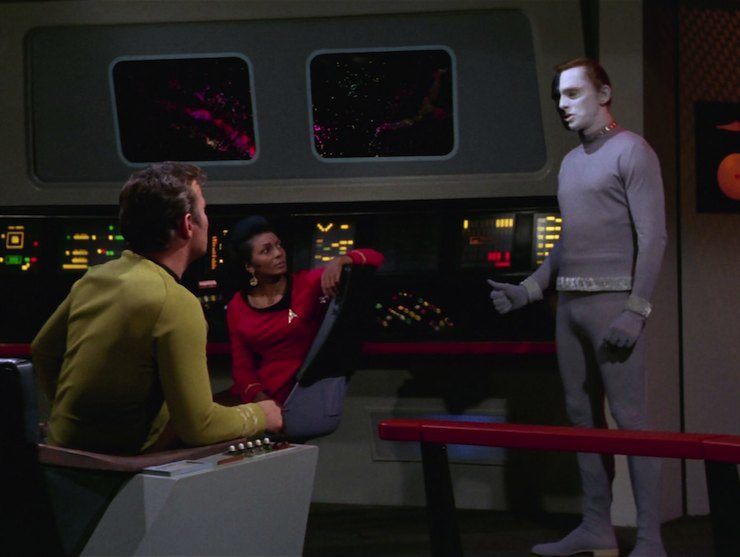
Bele is an officer of the law on Cheron, and he’s after Lokai. He wishes to take Lokai into custody, but Kirk isn’t quite ready to turn him over yet. Kirk and Spock do escort Bele to sickbay, where McCoy is tending to Lokai.
Lokai is a political prisoner: he is an agitator who is fighting for rights for his people—the folks with black skin on their left side—after millennia of oppression by Bele’s people. They obviously despise each other, and Kirk has to keep them physically separated.
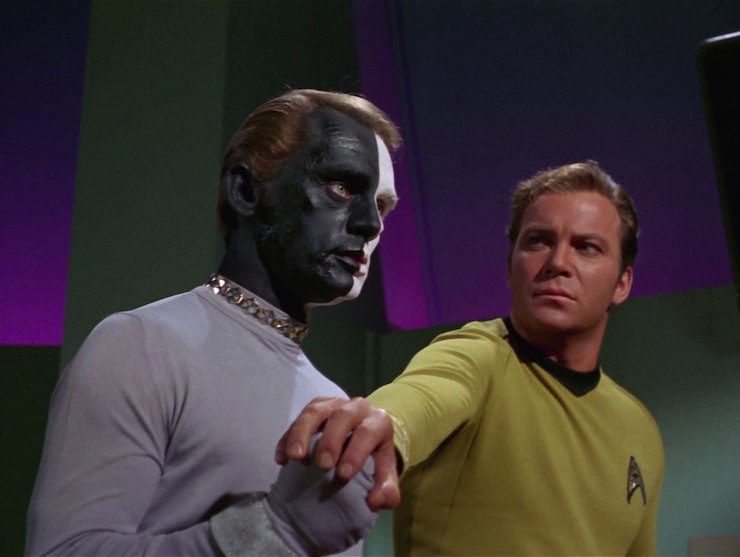
Kirk also points out that there is no extradition treaty between the Federation and Cheron. The best he can offer to Bele—who wants the Enterprise to go to Cheron immediately—or Lokai—who wants asylum—is to take them both to Starbase 4 and let the authorities there deal with them.
After Bele is sent to his guest quarters, Chekov reports that the ship has changed course. Scotty can’t regain control. Kirk calls red alert, while Lokai leaves sickbay. Bele appears on the bridge and announces that he has mental control of the ship. He has been chasing Lokai for 50,000 years, and he won’t wait any longer.
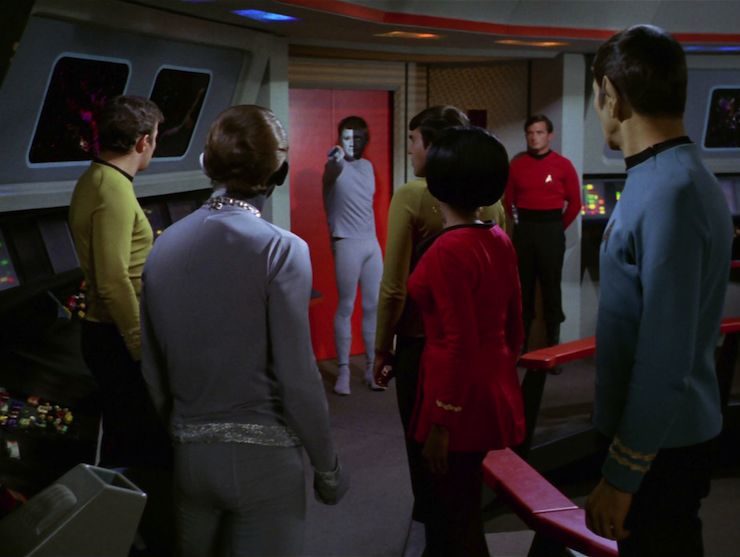
Lokai comes to the bridge and begs for sanctuary, with Bele making snide commentary about how he always finds fools to help him. Kirk tries to put them into custody, but they’re both protected by personal force fields, apparently.
So Kirk has one last card to play: he’ll destroy the ship. Bele insists he’s bluffing, so Kirk starts the self-destruct sequence. Bele holds out until the last second and then Kirk aborts the sequence and Bele returns control to Kirk. The ship heads to Ariannus.
Kirk doesn’t put them in the brig, and he encourages the pair of them to learn about the Federation from some of its finest representatives.

Lokai takes advantage, talking to some of the crew in the rec room, telling them of the oppression he lived under. For Bele’s part, Starfleet denies his request to take Lokai to Cheron immediately—there must be a hearing, in lieu of any extradition treaty between the two governments. Bele is also appalled to realize that the crew don’t understand the significance of the difference between him and Lokai: the side of the body that is black is different. To Bele, that’s everything, whereas to the Starfleet officers, it’s an irrelevant difference.
The ship arrives at Ariannus. Scotty supervises the decontamination procedure, and then Kirk orders the ship to head for Starbase 4. Kirk invites Bele to the bridge, where it’s revealed that he has burned out navigation and the self-destruct. The ship is back under Bele’s control. Lokai shows up and the two of them shout at each other and then attack. They struggle, even as Kirk tries to convince them that fighting will just end their battle prematurely.
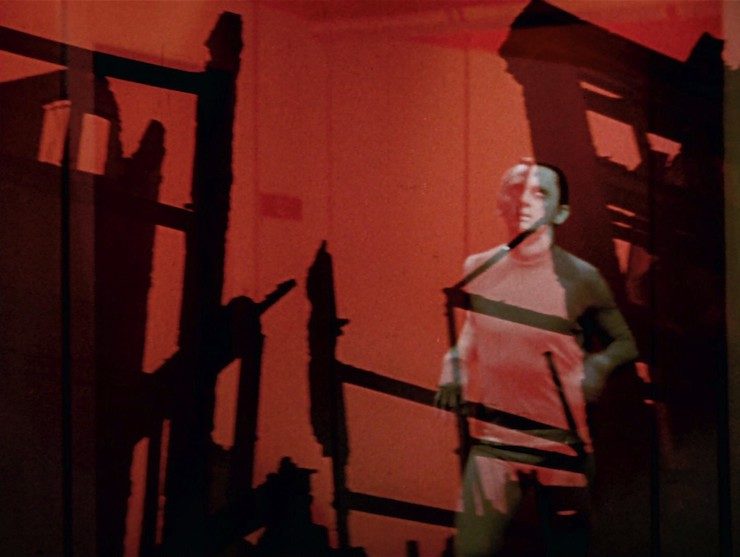
However, they’re almost to Cheron in any case, so Kirk proceeds the rest of the way there. Spock’s scan reveals cities, a system of roads, and lower animal life and plant life, but no sapient life. There are lots of corpses, though. Bele and Lokai are devastated to realize that the hate their people had for each other led to genocide. First Lokai leaves the bridge, then Bele chases him. They chase each other through the corridors for what seems like days before Lokai makes it to the transporter room and beams himself down. Bele follows.
Leaving them to kill each other, Kirk has Sulu set course to Starbase 4.
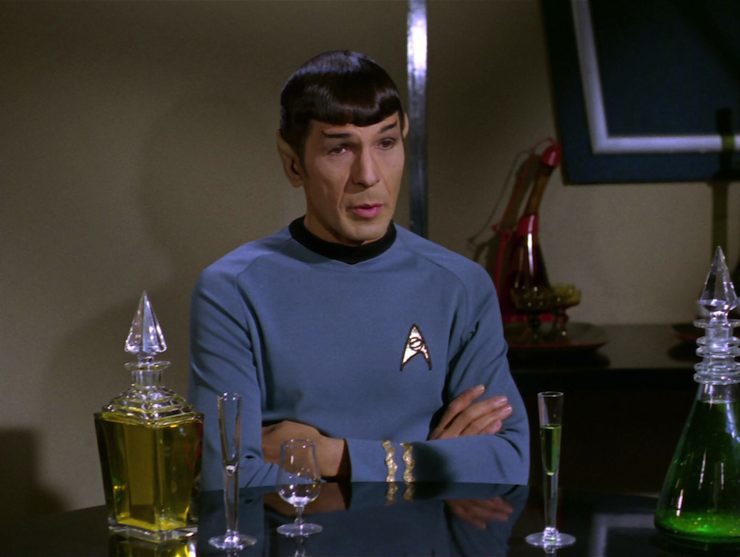
Fascinating. Spock gives Bele a bit of Vulcan history, consistent with what we’ve been told, primarily in “Balance of Terror“: Vulcans used to be savage and warlike, in much the same way the Cherons are, but they saved themselves by embracing logic.
I’m a doctor not an escalator. McCoy absolutely is sure that the odd pigmentation of Lokai is a one-of-a-kind genetic mutation that couldn’t possibly be a normal thing. Spock concurs. They are proven 100% wrong when Bele shows up and it’s discovered that there’s a whole planet of these folks. Oops.
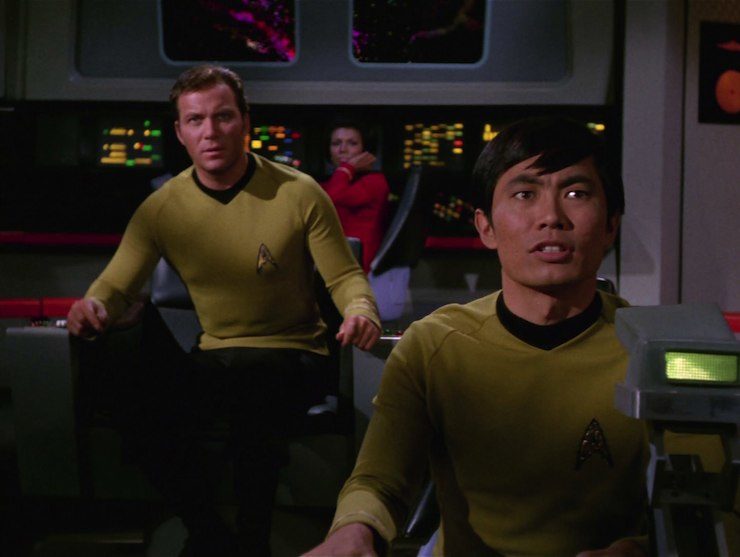
Ahead warp one, aye. Sulu, along with Chekov, talks about racial prejudice as an abstract and outdated concept from the 20th century on Earth. At the end, he wonders what they have left to fight for.
It’s a Russian invention. Chekov gets to report every time something goes horribly wrong with the ship. Sucks to be the ensign.
Hailing frequencies open. Uhura does her usual thing of passing on messages and hailing people and stuff.
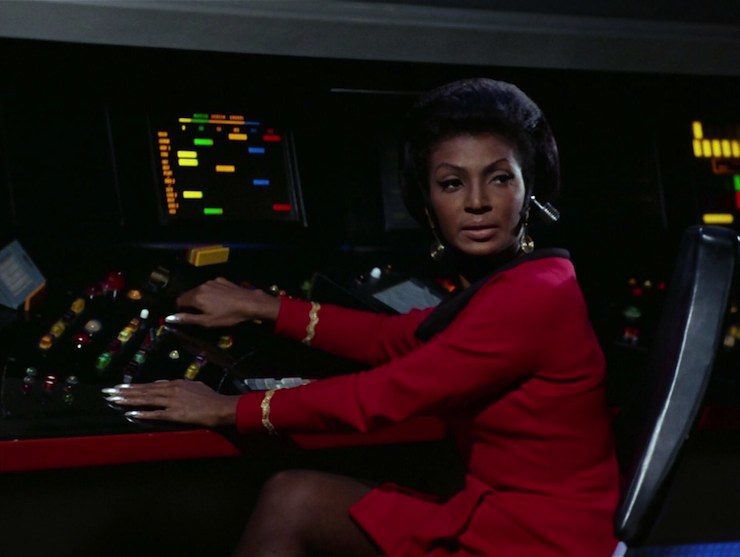
I cannot change the laws of physics! Scotty is surprisingly quiet on the subject of destroying the ship, calmly giving his code along with Kirk and Spock.
Channel open. “All that matters to them is their hate.”
“Do you suppose that’s all they ever had, sir?”
“No, but that’s all they have left.”
Spock, Uhura, and Kirk delivering the moral of the episode.
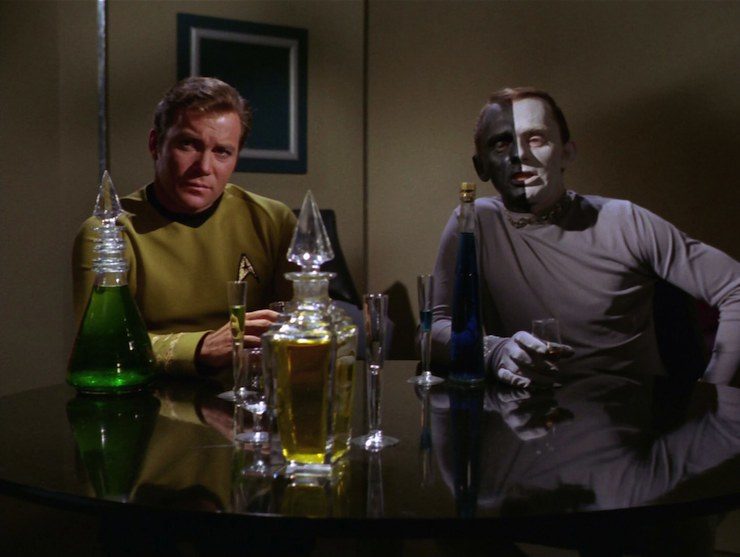
Welcome aboard. Having had Catwoman last week, this week we get the Riddler! Frank Gorshin, who is definitely best known for his role as the Riddler on the Batman TV series and its attendant movie, plays Bele. Lou Antonio plays Lokai, while recurring regulars James Doohan, Nichelle Nichols, George Takei, Walter Koenig, and Majel Barrett are all here as well.
Trivial matters: The sequence for the Enterprise self-destruct was repeated almost identically in Star Trek III: The Search for Spock, only in the movie, the sequence was completed.

The footage superimposed over Bele and Lokai running through the Enterprise corridors was stock footage of cities burning in Europe after aerial assaults during World War II.
The zooming in and out on the red alert signal, with the camera at a tilt, was allegedly an homage to Gorshin’s more famous role as the Riddler, as that kind of goofy camerawork was a hallmark of Batman.
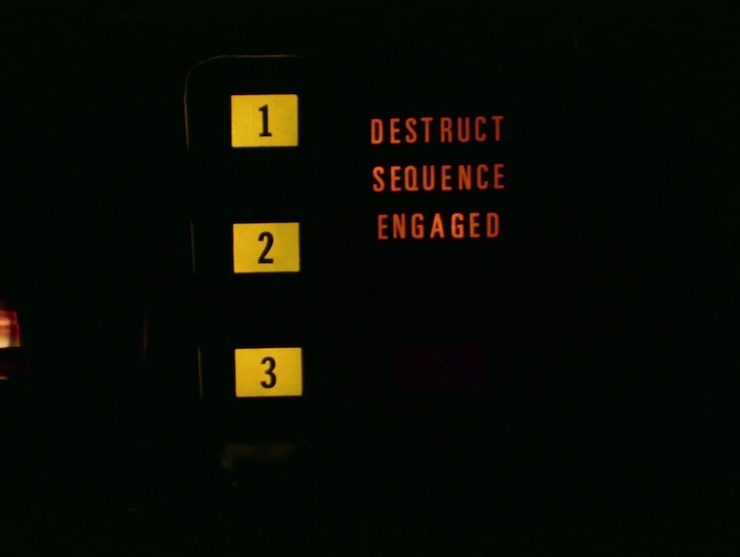
Gene Coon’s outline was originally written in 1966 for the first season, but it was never used. By this stage of the third season, they were using any old crap lying around the office, so they dusted this one off and gave it to Oliver Crawford to write a teleplay based on it. As with all of Coon’s third-season work—of which this is his last—it’s under his “Lee Cronin” pseudonym.
The Romulan War novels by Michael A. Martin established that a battle took place on Cheron during the titular conflict, which was referenced by Admiral Jarok in TNG‘s “The Defector,” though if it was the site of a battle during the Romulan War, Kirk wouldn’t have described it as being in an uncharted region…
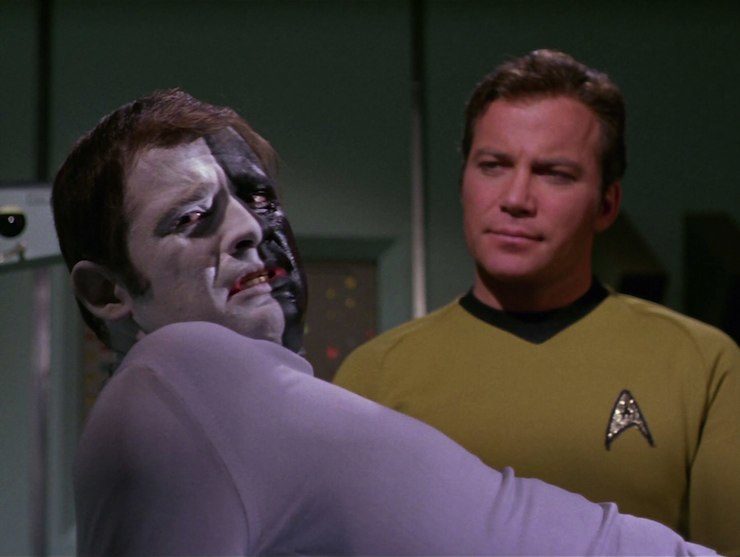
Greg Cox established in his novel No Time Like the Past that Bele and Lokai continued their conflict on Cheron, even though they were the only ones left.
To boldly go. “It doesn’t make any sense!” Whenever people write articles about how Star Trek did social commentary, this episode always comes up as a popular example of how brilliant they were at it.
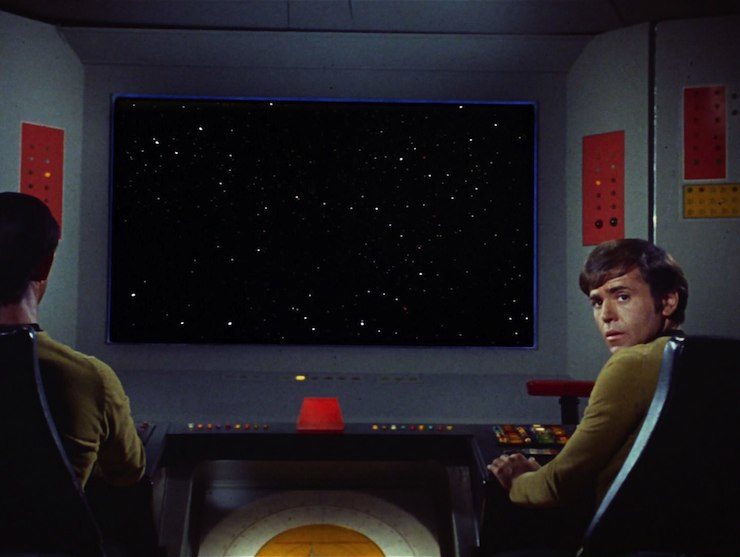
And every time I read one of those articles, my teeth hurt, because this episode is just awful.
The basic message is a good one. I love the total confusion on Kirk and Spock’s face when Bele explains that Lokai is so obviously inferior because of which side of his face has the white and black pigmentation.
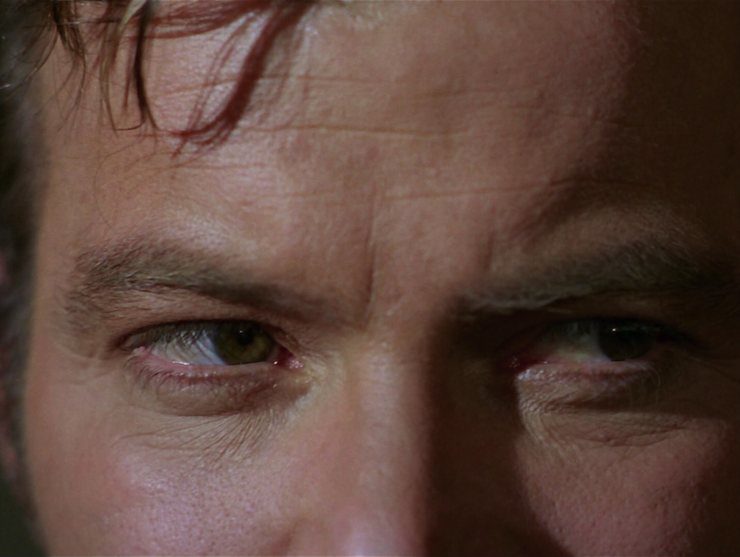
But that is all this slog of an episode has going for it. There’s only about fifteen minutes of story here, and it’s endlessly stretched out to an hour. Countless reaction shots as the crew wonders where the invisible ship is. Countless reaction shots as they realize the Enterprise is out of control. Simply endless closeups (including a bizarre fetish for closeups of eyes and mouths during the self-destruct sequence). Long drawn-out closeup reaction shots when Bele takes over the ship a second time. The spectacularly uninteresting decontamination procedure on Ariannus, which has absolutely nothing to do with the plot and should have happened between scenes, but no, we have to suffer through this simple procedure that goes off without a hitch because we need to fill time.
And then the final indignity, being forced to watch simply endless shots of Bele and Lokai running through corridors. And running through corridors. And then running through more corridors. And then, for good measure, running through yet still more corridors.
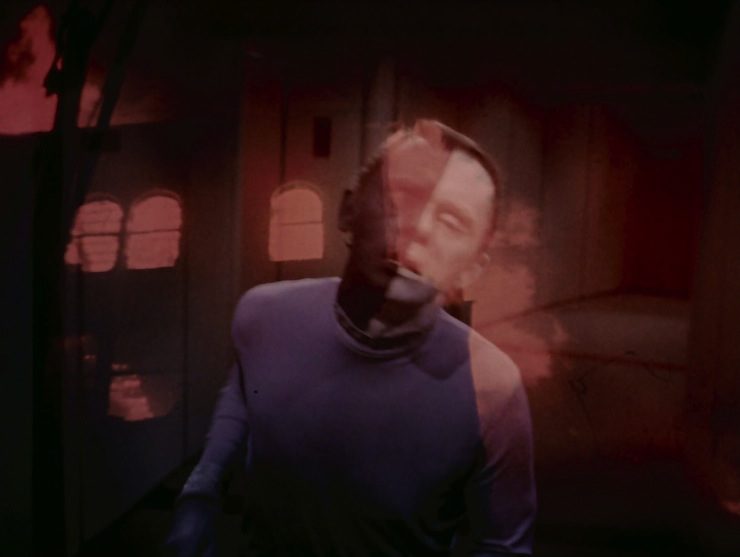
All wrapped around a plot that has the subtlety of a nuclear explosion, with the cherry on top being the sledgehammery bit in the rec room where Chekov and Sulu talk about the bad ol’ 20th century with its yucky racial prejudice, and thank God we don’t have that nonsense anymore. (And I’m just wondering where Stiles from “Balance of Terror” fits in…)
Okay, the episode has one other thing going for it: no one ever went wrong casting Frank Gorshin in anything, and he does a fantastic job as the hardliner Bele. An aggressively nasty turn, done in only by the doofy manner in which Gorshin runs through the corridors (which he does a lot, did I mention that?) at the end.
Warp factor rating: 3
Next week: “Whom Gods Destroy”
Keith R.A. DeCandido will be curating a special New York Review of Science Fiction event at the Brooklyn Commons, celebrating the 50th anniversary of Star Trek, featuring authors Steven Barnes and David Mack, as well as Tor.com’s own Emmet Asher-Perrin. It will take place Thursday the 8th of September—the actual 50th anniversary—at 7pm.










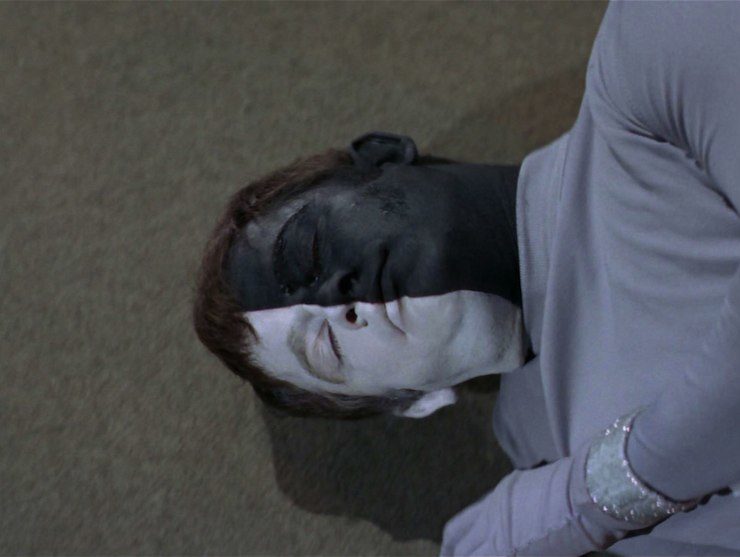
This is the only original series episode I can remember watching as a kid. I remember thinking it was really, really good, despite the goofy running. I’m not sure if that was mentioned in the recap. I probably thought that because I was quite familiar with Batman and loved that The Riddler was in this episode.
I’ll be interested to see what I think of it now once I rewatch it after all these years.
When I read these, I save up comments in my head. Except now I’ve completely forgotten what I was going to say, because your Swiftian tag in the comments threw me off completely. Always read the tags.
But really, the episode is terrible. The cinematography alone is just bizarre and fairly unusual for TOS. The plot might make an okay B-plot, not an entire episode. The only scene I like is the classic one, Bele explaining the difference between his and Lokai’s groups. The rest of it…yawn.
There are people who think this is an example of how Star Trek is brilliant at social commentary? Good grief. The only way this episode could have been more heavy-handed is if there had been a big “Racism Is Bad” musical number at the end.
While it goes unmentioned in the recap, there’s a very long/goofy running sequence through some corridoors. Perhaps rather than one guy chasing Lokai for 50,000 years, they should have sent two guys. Had someone been available to run in the opposite direction and intercept him, they probably could have cut that down to 10,000 years. 20,000 tops.
I can’t agree that the message of the episode is a good one. Yes, certainly the part where they highlight the silliness of racism is something we can all get behind, but it doesn’t stop there. They have to go on and show that Bele and Lokai are equally wrongheaded. In the context of the period, the point of the episode is pretty clearly, “George Wallace and Malcolm X are equally bad!” Which is BS. The episode is preaching equality out one side of its mouth while saying, “But you shouldn’t do anything too provocative to achieve equality.” If the episode were made today, you know it’d be critical of Black Lives Matters for being too belligerent.
As I observed some weeks back, I think the third season deserves some credit for trying to embrace ST’s moral/philosophical dimension perhaps better than the second season sometimes did, but it did tend to fumble the execution. This episode is a classic example. The idea of an allegory about racism is noble, but it’s just so damn heavy-handed that it’s hard to take seriously — and casting white actors in both roles didn’t help much. There’s also so much that’s ridiculous about the Cheronians. The idea of the two sides of the body being pigmented differently isn’t entirely out of the realm of possibility, given the way bilateral development happens (I’ve seen some cats that had “Two-Face” fur coloring to an extent, and of course there are the heterochromatic ones with two different eye colors), but it just looked so blatantly like pancake makeup and wasn’t remotely convincing. It would’ve been better if the makeup had been less obvious, if there’d been a bit of gradation in the middle instead of a sharp divide, and if it had included the hair as well as the skin (since, really, why wouldn’t it include the hair?) Plus, if they belonged to such mutually opposed cultures, why were they wearing the same outfit? (An outfit that conveniently includes gloves so the actors’ hands didn’t have to be made up.)
Also, this episode has a fault that was also common in the Fred Freiberger-produced episodes of Space: 1999 — giving the guest aliens a grab-bag assortment of nigh-magical superpowers. They’re immortal, they’re telekinetic, they have built-in deflector shields, they emit deadly heat when they fight… it’s just absurd. Did they need to be 50,000 years old? Maybe it would’ve been better if they were just the last survivors of two races that had been warring for 50,000 years. That would’ve made more sense, because if Spock detected bodies on Cheron, then the final collapse of their civilization must’ve happened no more than a few years before, maybe just months before, assuming most of those bodies were exposed to the elements. There’s no way the bodies of so many war casualties would survive for thousands of years. And getting home just months or a few years too late after a 50-millennium chase would be absurdly coincidental. And there could’ve been a better way for them to endanger the ship than telekinesis. What if they’d actually managed to convince some of the crew to take sides and help them?
And why the invisible ship? Why not just use stock footage of the blob-of-light ship from “Friday’s Child” or “Journey to Babel”? It took up so much time and was so totally pointless, and it ended up being just one more random super-ability out of the grab bag.
Meanwhile… How do you “decontaminate” a planetary bacterial infection… from orbit? Whether it’s a chemical or a biological agent, the intense radiation in space and the upper atmosphere would probably destroy it before it reached the ground. And there’s no way one starship would be able to hold a large enough quantity of the stuff to pervade an entire planet’s ecosystem. Not to mention the risk of killing more beneficial organisms in the process, like that recent anti-Zika mosquito spraying that accidentally killed a bunch of honeybees. Wouldn’t it have made more sense just to beam down a supply of medicine?
The self-destruct sequence is okay, reasonably suspenseful. The part I’ve always had a problem with was the reuse of the exact same sequence in The Search for Spock. Sure, it’s nostalgic and all, but are we supposed to believe that military personnel would keep the same passwords for 15 years? Heck, they should’ve changed the passwords as soon as they were used here. That’s basic security. It always annoyed me that TSFS put Easter-egg familiarity above common sense. It would’ve been better if they’d used the same structure for the sequence but changed the actual codes.
@5/Sean: You’re quite right. I had the same thought, that it suggested too much of a equivalency between the oppressors and the oppressed.
On a personal note, we’re all moved into our place. We’re not all unpacked yet — I haven’t even gotten my desk set up in my office yet, though that should be happening tomorrow — and the place is decorated in Early High Box, but at least we’re in. (It took forever to get everything out of the old place…..) The Rewatches should be back to (ab)normal going forward.
—Keith R.A. DeCandido
I’m not sure if I’ve heard this episode called “brilliant” but I’ve seen it as a counterpoint to the argument that anvilicious social justice messaging is some new thing that’s ruining SF.
I never, ever had a problem with the endless running through corridors, of this episode. I thought, and thought again when I rewatched last year, that for the emotional impact, it was perfectly paced — especially since both actors played the scene as exhausted, barely staying on their feet. I know I am in the minority (ha) on this.
@5/Sean – Yeah, this occurred to me, too, even though I myself recently recommended this episode as an example of Trek’s social commentary. It would have to be written far differently today. Being “color blind” in the sense this episode endorses can only be done by the privileged.
@6/Christopher – Heck, they should’ve changed the passwords as soon as they were used here. That’s basic security. It always annoyed me that TSFS put Easter-egg familiarity above common sense. Well, while it’s hard to argue that your point is sound, I think nostalgia is an okay defense since TSFS is full of nostalgia, from the tribbles in the bar to the casting of Mark Lenard. Maybe the codes aren’t so much the thing as the voice recognition (although I know that’s not stated on screen) – so no need for constantly changing passwords, so long as the right voices are speaking them. (Do I get a No-Prize?)
For once I agree with the review, but the rating is surprisingly generous. I consider this the worst third season episode so far.
It bothers me that Kirk is willing to destroy the Enterprise because Bele has hijacked it. After all, the Enterprise gets hijacked all the time, and usually he doesn’t try to blow everybody up.
When I watched this episode for the first time, and got to the scene where Lokai explains his point of view to some crewmembers, I thought, hey, if they both start recruiting followers, this could get interesting. Sadly, it never happened.
Jana: I went back and forth on whether or not to give this a 2 or a 3. I went with 3 mainly because of the sheer awesomeness that is Frank Gorshin.
—Keith R.A. DeCandido
Even when I watched this as an 8 or 9 year old kid in the late 70’s, I can remember thinking, “why are they running so much?”
@10 Mike: Voice recognition is very much subject to attack, too–as seen in TNG’s “Brothers,” after all.
It always seemed to me that self-destruct got easier and easier to activate as the franchise went on. In TNG, it only required two senior officers, and they didn’t even use bad passwords like they do here (MA adds: palm print identification? Yeah, that’s totally undefeatable.) In First Contact–well, okay, there it was 3 officers again and they had to give bad passwords. On Voyager–just the captain(!!?) and she used “Janeway-Pi-one-one-zero” more than once. I mean, yikes. No two-man rule of any kind, and an antimatter-powered starship is a more destructive weapon than any nuclear warhead in our time.
It was … unsubtle.
@14Voyager’s “Investigations” also had an incident in which an engineering officer used a password in front of Neelix– NEELIX– and then he was able to use it to gain access to some files, without even disguising his voice or anything. Starfleet’s physical and computer security is terrible, which if not entirely logical is at least consistent.
Speaking of, the Enterprise/Enterprise-D/Voyager are no more incompetent than the rest of the Starfleet. Starbase 4 can’t properly secure their auxiliary craft either, apparently.
dunsel: to be fair, Lokai’s been on the run since the Paleolithic. I suspect he has mad thieving skillz……
—Keith R.A. DeCandido
Krad, ha, I hadn’t considered that! Great point, and suddenly I want to pointlessly insert him into every bit of Star Trek history. I bet you while on the run he chilled out with Gary Seven, hung out with Guinan, and stole the Sword of Kahless on three separate occasions. Despite the ending of this episode, he continued to live on for another several centuries, became Future Guy, and was really pissed off at the Enterprise– but he got his names and dates confused and pointlessly harassed the wrong one. When you’re that old, your memory won’t be that great either.
“When 50,000 years old you are, look this good you will not.”
@5: I’d say this episode got it right; Bele and Lokai’s people are equally dead. A commitment to permanent conflict can accomplish that.
Guess I’ll be the crazy one here and say that I like this episode quite a lot, but then I prefer Star Trek when it’s completely bonkers. There seemed to be a greater appreciation for the absurd in ’60s television, or at least a greater willingness to try it, and “Let That Be Your Last Battlefield” is a prime example. Sure it’s subtle as an atom bomb, but I love it all the same, particularly for Gorshin’s performance. If only he’d found an excuse to do a Shatner impression…
I can’t defend the rapid zooms, but I wouldn’t say the closeups on eyes and mouths are “bizarre” for the time. This was 1969 after all. Sergio Leone movies were popular. Nice to see some European influence for once.
I do find it odd they didn’t bother dying their hair black and white. Same goes for their space pajamas. If you’re going to have split characters, guys, you gotta go the full Two-Face. Black and white suits are a must.
When I first saw this episode as a kid (in syndication) and saw the burning buildings in the background during the corridor chase I had assumed that Bele and Lokai were having visions, imagining what was happening / had happened to their society, possibly each blaming the other for the destruction.
Years later when I read commentary about this episode, the burning buildings were described as intentionally hitting us the audience over the head with the historic allegory.
I think I always wanted to stick to my impression, even after I read this.
Even as a young teen, I found this heavy-handed. Yeah, we get it. Racism = bad. Hello captain hit-you-over-the-head friggin’ obvious. Zzzz.
The show was just plain dull.
Was “racism is bad” the only moral of the story? Of course it starts out that way, but by the end I thought it veered into a commentary on Mutually Assured Destruction… which we learn is also bad. Go figure.
I saw this when it originally aired when I was ten years old, living in New Orleans, Louisiana. Raised seeing the “whites only” and “coloreds only” water fountains and bath rooms, and all the other horrible madness of that time and place, all I know is that this episode hit my little ten year old mind like a mind-grenade. Because beyond all the obvious criticisms I read in the comments above (which all have their validity) I think the main point that struck me then and is still with me is that hating someone because you are white and they are black would be just as stupid as hating someone with their half-colors reversed.
Seriously, the deep South was a heavy-handed, cartoon like kind of place back then to live in, and one that confused the living hell out of me (a nightmarish cartoon full of caricatures that were enforced with violence on living human beings), and I was always glad for that episode helping me think about the stupidities all around me.
If all it did was help children like me (however unsophisticated) to see some truth and think about the stupidities in my culture, it did a great thing indeed. The “running in the passages scene” echoes in my mind still, and in my remembered ten year old mind I can recall how I was struck with how it reflected the craziness I experienced at school and in everyday life.
Thanks, Star Trek, even and especially for this episode, which made a difference for me.
Jedikalos: thank you for that important perspective.
—Keith R.A. DeCandido
@25 I saw in some think-piece not long ago that Star Trek, in the opinion of the writer, was not especially for adults or kids but was for “smart kids.” Now I’m not sure I fully agree with that point, since the tone and execution of the franchise over the past 50 years has varied greatly, but in the case of this episode I think it rings true. Sometimes these things can be the equivalent of a tall tale—fantastic, absurd, obvious, and yet mind blowing if taken at the right age. It’s something that makes you question your world and you never forget it.
Anyhow, thank you for sharing your perspective.
I’ll gladly take a heavy-handed, ham-fisted allegory about racism in 1960s America with puzzling makeup and costuming decisions, godlike mental powers, inexplicable personal force fields and endless running-through-the-corridors scenes over any episode of the Kardashians or Real Housewives or Honey Boo-Boo.
I’m annoyed with the Enterprise hijackings because they should be easy to stop- shut the engines down. Regular power/ motive sources have safeguards, nuclear powered ships have literally books (RPM volumes) on automatic shutdown circuits; an antimatter powered spaceship ought to be relatively easy to immobilize. Stop a fuel pump? Depower the ECM equivalent? Fake a high coolant temp alarm?
Agree with Jedikalos; this was not so heavyhanded decades ago.
@25 This is my husband’s favorite episode of all of Star Trek for exactly the same reasons. The only difference between his story and yours is that he was 12 and living in Abbeville, Louisiana. Thanks for expressing it so well!
A great, if rather simply, idea terribly executed. However, I do like the self-destruct sequence as it is a pretty tense scene.
@22: That’s also how I always interpreted the burning building footage. While it is true that it is recognizable WWII documentary footage, I don’t think it’s aimed at the viewer. I think the intent is to depict the fearful images flashing through Bele and Lokai’s heads. To try to show that it they could only imagine the consequences of thousands of years of hatred when it was already too late.
“It bothers me that Kirk is willing to destroy the Enterprise because Bele has hijacked it. After all, the Enterprise gets hijacked all the time, and usually he doesn’t try to blow everybody up.”
In fact, when the idea of blowing up the ship because it was hijacked is raised by Scotty and Spock in another episode (“By Any Other Name”), Kirk rejects the idea strongly.
I feel like the “chasing people through the corridors” sequence may have been inspired by how much time they spent padding season one episode The Alternative Factor by weird ‘action’ shots.
@25, 30: That’s impressive. I think I like the episode a little better now (although I still don’t feel like rewatching it any time soon).
For better or worse, this was the episode that cemented Trek’s reputation in the mainstream as a “Message Show” and that reputation is probably why it has kept being brought back (three most recent movies exempted, of course) time and again. It certainly carries a lot of baggage, and message shows have been done a lot better and a lot worse in Trek ever since.
I think that this is one of the essential TOS episodes for that reason. Not necessarily good, but essential nonetheless.
To commemorate that self-destruction code re-use and continual return of Trek, have a song:
https://www.youtube.com/watch?v=pmhOS1ywdjs
@27 I think that’s an interesting point, and an important one, that you bring up. You almost want to show something like this to kids over adults, because they’re the ones who can benefit from it the most.
You know, show it to them when they’re young, before those ideas about race they’re being exposed to every day have a chance to catch hold and germinate, and maybe something better might catch hold and germinate instead.
Kids aren’t born knowing how to hate, at least not this kind of poisonous, institutionalized hatred; they have to learn it over the course of many years, and if you plant a new idea in their head early enough, they may not accept that institutionalized hatred quite so readily.
@37 Well put, Denise. I agree. And I’d be curious to hear how today’s kids would react to this episode… if they could manage not being bored by it. A struggle, I know, but still…
@6 – “The idea of an allegory about racism is noble, but it’s just so damn heavy-handed that it’s hard to take seriously — and casting white actors in both roles didn’t help much.”
For the effect they were going for, both actors had to be at least the same race. The difference between the Cheronians that those two characters thought was so obvious and important is something that probably slid by most viewers until Bela indignantly points it out. Having the actors be different human races would have provided a visual clue that would have ruined it.
Also, part of theme here is that vengeance is a destructive force in itself . Lokai is not a good guy for all that his people have been oppressed. His hate is just as destructive to their species future as Bela’s.
Agrred that the two aliens are over powered and that Bela’s pursuit of Lokai for 50,000 years is qratuitious and that Writer’s Have No sense of Scale in time, as well as in distance and volume..
Does Lokai take lap or two around the saucer section? I would not think there were enough corridors to get them that exhausted (I realize there is nod that they have changed decks).
@39/Crusader75: “Also, part of theme here is that vengeance is a destructive force in itself . Lokai is not a good guy for all that his people have been oppressed. His hate is just as destructive to their species future as Bela’s.”
But as has already been mentioned, that feels like a false equivalence in the context of the day. It’s like saying that “Sure, racism is wrong, but fighting against racism is just as bad.” Or “I’m against slavery, but I’m also against slaves rebelling or running away.” Or “I’m against men beating their wives, but it’s just as bad for the wives to fight back in self-defense.” That’s bull. You can’t treat the oppressed’s resistance as being equivalent to the oppressors’ abuse. There’s a fundamental asymmetry of power there, and pretending that the asymmetry doesn’t exist is the same as taking the oppressor’s side.
Elie Weisel said it best: “Neutrality helps the oppressor, never the victim. Silence encourages the tormentor, never the tormented.”
And yes, of course, the situation as presented makes Lokai seem equally bad, but the point is that the writer’s choice to present it that way undermined the episode’s message by misrepresenting the struggle between oppressor and oppressed as a level playing field.
This episode is a classic example of the term ‘heavy-handed’. Trek has encountered this problem several times before when it came to moral plays. It’s not enough to present the conflict. For whatever reason, the writers feel the need to beat the viewer over the head with it, even though it’s right there to be seen. Since there isn’t much more to the episode than the chase between these two, we get scene after scene of the same beat over and over again.
Even the self-destruct sequence is shot in an over-the-top manner. We don’t need close-ups and rapid-fire editing to see if Kirk’s gambit will scare Bele and Lokai.
That’s too bad. The actual concept is pretty good, and it showed a willingness during the third season to try interesting ideas (that’s before I learned it was an unused first season outline). But it’s mired in the most basic mundane plot. Boring, repetitive, with the worst possible pacing. It feels more dragged than a soap opera. I can see why Gene Coon threw it away. Even OIiver Crawford, who was one of the writers of The Galileo Seven, couldn’t salvage it.
Speaking of Lou Antonio and his career, I’m surprised he never directed any episodes in any of the Trek shows. When you look at his bio, he had a highly prolific TV directing career. He was very active during the TNG/DS9/Voyager era, and directed everything from Party of Five to CSI and Picket Fences. I’m surprised neither Roddenberry nor Berman hired him. I guess he was that busy.
@40: This is a poor interpretation because the crew of the Enterprise acts as a counterpoint to the Cheronians. Humanity overcame racial hatreds and moved on while Bele’s domineering and Lokai’s thirst for vengeance led only to complete destruction. Fire need not be fought with fire and “It’s OK when we do it” is a siren’s song.
@42/fronzel: But if the intent was to draw an allegorical comparison with real-world racial tensions, then it was very wrong to say that both sides were equally to blame for those racial hatreds. Europeans enslaved Africans, not the other way around. The blame is very much one-sided.
Even in-story, treating it as equal is wrong. Bele admitted that his people had enslaved Lokai’s people, but he blamed them for continuing to fight for their rights after they were freed. His rhetoric about their “failure” to make good use of their freedom is no different than the rhetoric of the racists — in the ’60s and today — who deny that oppression still exists and pretend that the people fighting back against oppression are merely criminals.
I suppose the episode was a response to the race riots that were common at the time, and sure, you can validly argue that rioting wasn’t the most constructive way to achieve change, that nonviolent protests like those by Rosa Parks and Dr. King were more effective. But that doesn’t make it right to treat it as exactly equivalent to the enslavement and oppression that bred such anger in the first place.
@43: I still have to disagree. In this fable there is no difference between Bele and Lokai’s people because they are all dead, which is the very point that the story is making. A conflict ends when the participants put it behind them or they are all destroyed. Lokai isn’t any better than Bele because he has nothing to offer anyone, not even himself. His values of “justice and freedom” are as meaningless as Bele’s values of “peace and order” because everything has come to mere ash. It doesn’t matter “who started it” as there is nothing left but two opposing survivors who, as it is spelled out, have nothing but hatred left inside them.
The story isn’t positing a false choice of tolerating injustice or suffering destruction, it’s just saying, as I posted earlier, a commitment to permanent conflict creates nothing.
You can make an episode about how two sides committed themselves to permanent conflict, neither was better than the other, and everybody died.
You can make an episode about racial tensions between blacks and whites.
But they shouldn’t be the same episode.
@44/fronzel: Yes, yes, you’re just restating the point of the episode as disconnected from anything in real life. But the point I and others are making is that using that particular story as an allegory for real 1960s racial tensions is wrong, because it implies a false equivalence in that case, and thus is essentially racist in itself. Greenygal says it quite well in #45. It’s the wrong story to tell if you want to comment on race in America.
I couldn’t get behind the so-called message of the episodes because, as Sean O’Hara, CLB and others have said, it paints the picture that oppressors and those fighting oppression are equally wrong. Greenygal said it very well. The message is totally undermined by the story drawing a false equivalency between enslavers and those who have been enslaved, freed, and are fighting the social effects of that slavery. Bele says basically Lokai’s people didn’t know how to use their freedom, weren’t grateful for what little they were given. Boy, that hit me like a bucket of water, as I hear that all the time today.
To try to say both sides are wrong and should stop fighting is like saying black people should have just accepted Jim Crow and every other form
I can only hope this was in fact directed at children and young people whose minds are still forming and haven’t fully embraced prejudice and bigotry, as Jedikalos and others’ thoughtful comments show. Shown to a young person, it can be effective in highlighting the absurdity of racial hatred. I admit it was for me when I watched as a child. But today, I can see very clearly where it falls apart.
Hey, I’m comment #47. Cool
The most absurd thing about this episode, I’ve always felt, was the idea that Bele had been chasing Lokai for 50,000 years. I mean, even if Cheron’s “year” was only 10 Earth days or so (picture a planet like Proxima B whipping around its very small sun), that’s still like 1500 years. And it adds absolutely nothing to the story.
I have to disagree with Christopher and others, however, that the episode gave the wrong message on racism. I felt it clearly displayed the smugness of the oppressor Bele, as well as the desperation of Lokai the oppressed. I also don’t fault our heroes for not taking sides, as it isn’t their battle. With limited time and means of sorting out the truth, referring the matter to the Federation would be the proper protocol.
The moral of the story is that after a certain point hatred takes on a life of its own. In the end, it really doesn’t matter who “started it” when everyone is dead as a consequence. As a person of color who has experienced racism and hatred from both whites and blacks alike, this is clear as day to me.
Kevin: Bele specifically said “50,000 of your terrestrial years,” so that was him translating into Earth terms, so it really was that long. It’s possible that on Cheron that’s only a decade or so, given that they’re obviously very long-lived………..
—Keith R.A. DeCandido
I’ve found many of the Rewatch reviews to be unduly harsh towards a fifty year old wshow that commits the sin of “not aging well” in terms of some its politics, technology and social commentary. Actually I hold this episode as a favorite along with “Arena'” both episodes which have aged into fine cheese, with LTBYLB being more pungent. I saw this ep. at first airing ( 8 years old ) and I consider myself a child of the riots that took place in my native Baltimore the year previous ( And the site of 21st century riots less than a mile from my home ). It remains my favorite because underneath the greasepaint and Shatner giving us the Full Shat, and had the nerve to embrace it’s nihilism…. And point out the absurdities of race and racism in a way the “Smart Kids” could understand.
My primary complaint about this episode, truly, is that there isn’t enough story here to fill an hour. That has absolutely nothing to do with the show being 50 years old and everything to do with a script that had no idea how to tell the story in 48 minutes and so gave us more filler than an overstuffed Twinkie.
—Keith R.A. DeCandido
@51/krad: Good point. They could’ve added a lot by fleshing out Cheron’s history and culture more fully, deepening Lokai and Bele beyond one-note archetypes of their respective sides. Or by having their conflict catalyze a dispute among the crew, a disagreement over which one had the more sympathetic cause. It was just too elementary, too superficial, and it didn’t have to be, since there was plenty of room to add more substance.
I too never liked the fact that both guests end up being in sides of a conflict where both were wrong.
@16 – Dunsel: I love it how you say “@an engineering officer used a password in front of Neelix– NEELIX”. :)
@29 – sps49: This was not so heavy handed in the 60s, but then again, krad is doing a current day rewatch. There is a lot of stuff in the show he calls out for being racist or sexist, and it wasn’t considered so back in the day. I do appreciate the experiences shared with us by those of you raised in the South back then.
@36 – random: You might not like the Kelvin timeline films (I find Into Darkness boring), but they still have a message.
About the running scenes and overstuffed Twinkie-ness: watching some of the TOS episodes on Netflix has been a revelation as to how much better they were in their original form, but I’d argue that this, and several other similarly-padded episodes were actually better in syndication where the edits-for-time helped rather than hurt.*
And, I can remember in my earliest childhood watching of this — which was likely the summer repeat of the original airing — finding the self-destruct sequence, Sergio Leone closeups and all, unbearably suspenseful.
(I was 8, and deemed old enough to watch this show, in the third season — but only during the summer when it didn’t conflict with bedtime. I wonder if my long-term perception of the show was affected by having first contact be with the crazily spotty last episodes.)
*(Speaking of which, has anyone ever written about that? Were the syndicated episodes edited by the studio, the local stations, or both? Which were done well and which were butchered?)
So I finally got around to watching this last night. My fears were confirmed. I was definitely an idiot for liking this as a child. It’s just blatantly obvious, the tension is extremely forced, nothing really ends up happening, and, worst of all, both Lokai and Bele are so damned unlikeable that it’s hard to feel sympathetic to either of them.
You know what actually bothered me most about this episode? When they go to red alert and show other crewmembers just WALKING to their posts with no sense of urgency. I have a feeling that was reused footage, but, come on.
It was third-season Star Trek. Pretty much any shot that didn’t have characters speaking dialogue was probably reused footage…………..
—Keith R.A. DeCandido
Okay Paramount and CBS does own the cheron man like lokia and bele
The only two guys that been on TV
But what about the rest of it dead planet I don’t think so not in the fan world
We have cheron women cheron children cheron and babies and teenage
I guess we can play with all it
They lost out on something that could’ve gone into the right direction
oh well
I had never seen this episode before, but after 20+ years of Trek fandom, I was well aware of the revelations of the last act. Like others, I thank those who are writing from the perspective of having originally seen this as a child in the South in the late ‘60s. Can anyone speak from the perspective of seeing this without foreknowledge of the underlying message? Would a child of the ‘60s have seen this and not realize the issue between the men until it was spelled out by Bele?
I agree that, today, the message is rather sledgehammery, and I agree with those who say that it was wrong to not take sides in the script, to say that both sides were equally complicit in the conflict. That struck me as I was watching the episode, and it felt wrong to hear it. It doesn’t hold up quite as well as other episodes, but for the time, I suspect this was as important an episode as “Far Beyond the Stars” was in the ‘90s, if not as well told.
In the immortal words of Rodgers and Hammerstein:
You’ve got to be taught to be afraid / Of people whose eyes are oddly made / And people whose skin is a different shade / You’ve got to be carefully taught.
You’ve got to be taught to hate and fear / You’ve got to be taught from year to year / It’s got to be drummed in your dear little ear / You’ve got to be carefully taught.
You’ve got to be taught, before it’s too late / Before you are six, or seven, or eight / To hate all the people your relatives hate / You’ve got to be carefully taught / You’ve got to be carefully taught.
I found it amusing that after Bele shows he can mind control the ship, then nearly plays chicken to the point of the Enterprise’s destruction, Kirk’s reaction is to invite him to have drinks with the fellas. Did it not occur to anyone that he could direct his mind bullets to the self-destruct sequence if he wanted to? And then when they go chasing each other around the Enterprise, Uhura asks if she should assign a security detail and Kirk is sgain blasé about it asking where could they run? Well how about engineering or any other place where they might intentionally or inadvertently harm crew members or cause damage to the ship?
Also interesting to me was the mention of Darwin’s theory of evolution, which is thrown out there as a point of discussion but never followed up on. Probably as far as they could go with that in 1960s network tv drama.
@59/JohnC: No, I think evolution was pretty uncontroversial by the ’60s. The rise of the religious right and its anti-science hysteria was a more recent cultural development; they were always there, but I don’t think they had as much political clout as they started to gain in the ’80s and after, when political lobbyists began cultivating Christian fundamentalists as a voting bloc and politicizing issues like abortion and creationism, when before, devout Christians had preferred to stay out of anything as secular as politics. In the previous generation or two, from the ’40s to the ’70s, American culture tended to be very pro-science and pro-modernity, priding itself on embracing rationality and progress and turning its back on old superstitions. I’ve seen a number of movies from the ’40s whose sensibilities seemed more modern and forward-looking to me than a lot of more recent entertainment. In the past generation or so, we’ve seen a resurgence of traditionalism and anti-scientific thinking as a reaction against the prevalence of science and rationality in earlier American discourse. We’ve gone substantially backward in that regard since the time of TOS.
For example, just look at the popular 1955 play Inherit the Wind, adapted as a feature film in 1960 and a TV movie in 1965. It’s hardly sympathetic toward its creationist characters, and it uses the persecution of Scopes for teaching evolution in the 1920s as an allegory for McCarthyism in the 1950s. So it’s certainly not true that evolution had to be treated as some shameful secret in 1960s media.
CLB – points taken. Just had a flashback to my 7th grade science teacher, an elderly Christian woman who one day stood up before our class in 1975 and in an angry trembling voice told us that she had been chastised by the administration and was now required to teach us about the theory of evolution although she considered it a bunch of horse crap. Yes, she was a science teacher.
@61/JohnC: I had a creationist biology teacher in 9th grade. Which is weird, because I went to one of the best public schools in the country with a generally excellent faculty. At least he didn’t try to proselytize us, just taught the book but asserted that he had a separate opinion.
I didn’t mean to suggest that there weren’t creationists back then; there were always some of them stubbornly clinging to their illusions. They just didn’t have enough clout at the time for the makers of fiction to feel they’d get in any kind of trouble if they acknowledged evolution as a fact. At least, that’s my impression. There was certainly plenty of sci-fi in the ’50s, ’60s, etc. that was predicated on the idea of evolution and an Earth much older than 6000 years. Consider all the dinosaur movies, or Planet of the Apes. They got the time scales and the mechanisms of evolution drastically wrong, but they accepted the existence of evolution as a given.
I write this from August 2017, the day after violent conflicts between white supremacists and anti-fascist protestors resulted in the murder of one of the protestors and several other injuries and deaths. An event where people carried the Nazi swastika alongside the Rebel flag and gave the Sieg Heil salute. A literal torch wielding mob. In a time when there are known white supremacist propaganda mongers on the White House staff, after at least two years of rioting and protests over the unjustified killing of unarmed black men by police.
It’s arrogant and self-satisfied to look at this message as “heavy-handed”, regardless of any other flaws the episode had the core message at its heart is vital and necessary and clearly wasn’t obvious and hammered in enough because we clearly still haven’t &%$*ing learned. We’re still on Bele and Lokai’s path to oblivion. We’re still killing each other over differences every bit as ridiculous and meaningless as “black on the right, white on the left rather than the other way around”. The message of the story is as important today as it has ever been.
If it were up to me, this episode would be cut for time and to remove padding and unnecessary scenes and made required viewing in every school in America. Maybe if we can show the next generation early enough how foolish and destructive and pointless and doomed it is to hold on to hatred, we might actually have a chance to become the enlightened species shown to us in Star Trek. We’re shown two stark choices here, which set of people will we be? The fools who hate and fight and kill one another and destroy their entire world in the process, or the intelligent ones who live together in harmony and respect and have made it to the stars?
Right now we’re on the bad path. Maybe, if enough people absorb the lessons of this story, it isn’t too late to change course.
Han Rasmussen: I wish I could disagree with you. I’m incredibly sad that I can’t.
—Keith R.A. DeCandido
@63/Han Rasmussen: I have to disagree about this episode’s relevance, for the reason I and other commenters discussed above: The fact that it draws a false equivalency between the violence of the culture that practiced slavery and oppression and the violence of the culture that fought back against slavery and oppression. That’s no better than Mr. Trump saying that “many sides” were to blame for the Charlottesville violence. It’s a weak, pandering response to racial conflict that totally dodges the singular culpability of one side.
Violence against oppression is not a blank check to murder at will or it shouldn’t be.
@66/roxana: Of course not, but that’s not the point. The point is that it’s morally bankrupt to say that practicing oppression and fighting against oppression are the same thing. As Trump’s non-condemnation demonstrated, claiming moral equivalency in such a case is tantamount to siding with the oppressors. See the Elie Weisel quote I cited in comment #40. “Neutrality helps the oppressor, never the victim.”
krad points out the scene with Chekov and Sulu and their “thank God we are so enlightened that we don’t have racism anymore” nonsense. In a few of the season 1 episodes (especially Galileo 7 comes to mind) Spock was the subject of overt, vicious racism by his own crewmembers. And over the course of the various series and movies, there’s PLENTY Of racism to go around by and between the humans, Klingons, Cardassians, Romulins, Bajorans, Ferengi, etc. etc.
As for this particular episode’s commentary on the issue, I am struggling to refrain from waxing political given current events, and I don’t think I will succeed. Here in the US and around the world, there is a growing movement by racists who have co-opted victimhood from the real victims. They lament the days when one could discriminate out in public without fear of being called out for it. Those are the good old days to them. They have to be creative now. MAGA is code for them, as are “war on Christianity”, “All Lives Matter” and other labels that they attempt to dress up as inclusive, when in fact they are dog-whistles for bigots. I’ll shut up now, except to say that while this episode was definitely poorly-done, heavy-handed, and misguided in morally equating oppressive hatred with hatred of opression – there’s a kernel of a sad powerful truth in the twisted faces of Lokai and Bele.
Sounds like we are in basic agreement. However the trouble with extending privilege to those resisting oppression is that it can be used to justify indiscriminate and counterproductive violence.
From what we see of Bele and Lokai neither side was willing to try for a less violent solution. Or those who were were totally outnumbered.
I remember a snippet from the Star Trek Blooper reels which shows Frank Gorshin dramatically announcing “I am Commissioner Belly – no I’m not.” as the rest of the cast falls to pieces laughing.
The episode’s message rings false now, as does the “many sides” proclamation from he of the perpetual bad hair day, but at the time it worked.
That is the thing about “Message” fiction, it is tied to the audience of its day and often ages badly as the message becomes more refined and the audience learns more. Its message is a hollow one now, because we all know better (even if some people, currently reeking of citronella and shame, try to ignore that better understanding), but if you took our modern understanding of the issues back to the 1960s then it would be so far out in front of the then-audience’s frame of reference that it would gain little traction. It has to tell what Terry Pratchett called “Lies to Children” (or lies to the ignorant) in order to prepare them for a better understanding of the truth later. It presented the simplistic message in a way that could be understood then, and that helped move mass understanding of issues on so that a better message could come later.
And lets not pretend this has changed. We’re still telling clod handed simplistic messages in simplistic ways so that idiots like every single one of us reading this can understand, and our children, grand children, and great grandchildren will look back on message shows of this era and the social justice campaigns of this era as being simplistic and false too; because they will have an even better understanding of issues and the ways to move forward. Our earnest pleas will age just as badly as this did, but that is a good thing.
@69/roxana: “However the trouble with extending privilege to those resisting oppression…”
The trouble with that sentence is that it doesn’t make any damn sense. Victims of oppression, by definition, do not have privilege. They have the exact opposite of privilege. Acknowledging that they have a right to defend themselves against being enslaved, assaulted, and murdered with impunity is not granting them a privilege, it is recognizing their basic human rights.
Sigh. I don’t express myself well do I? I meant privileging their violence by saying whatever they do is automatically justified.
The episode is bad, for all the reasons mentioned, but the black-and-white faces of the guest characters make for a memorable visual impression. They convey the message much better than the actual story. On second thought, I find that it deserves some credit for that.
@72/roxana: Nobody is saying anything remotely like that. It’s a complete straw man.
I didn’t say you were. I meant that something like that COULD happen if the idea of resisting oppression justifying anything is pushed to hard.
@67 – “The fact that it draws a false equivalency between the violence of the culture that practiced slavery and oppression and the violence of the culture that fought back against slavery and oppression.”
All that means is that you entirely bought into Lokai’s version of their history as the truth. That the only thing he and his people did was secure their rights and did not try to seek vengeance. The question is not that cannot fight oppression but how you do it and where you stop.
Perhaps Babylon 5 did a better job of showing a cycle of hatred in the conflict between the Centauri and the Narn.
Sorry folks: this is just a bad episode from a weak season,and shouldn’t be rated more than a “1” — it’s poorly written, the makeup is atrocious — it’s over-acted — as noted, there is about 20 minutes of plot and 30 minutes of padding and running in corridors.
If this wasn’t Star Trek, you’d turn it off after 5 minutes. Any merit to the argument that “racism is bad” (duh) is lost because of the leaden, heavy-handed way it is presented.
Again: you do have to view it in context. After decades of presenting bland white conformity on TV, by the late 60s, they were falling all over themselves to “prove” they were not racists and opposed racism. Racism BAD!
BTW, trying to tie this in with Trump or MAGA or Charlottesville….please, folks. This was written and filmed 50 years ago, in a totally different social environment. With the calibre of actors, writers, producers available to Star Trek, they could have done some magnificent shows about race, prejudice, bigotry — and sometimes they touched on these — but they could have done more. This is a HUGE missed opportunity for that reason, and unforgivably lame.
It is one of the few episodes I avoid watching — as much as I love the series — the other is the Melvin Belli one — I find them unbearable. Which is awfully sad.
What this brings back to me (just reading about it) is how the show was jumping the shark at this point, straining to produce episodes that had flowed so effortlessly in the first two seasons. That’s even sadder than the awful, pathetic, fake, “blackface/whiteface” makeup — possibly the worst makeup I’ve ever seen, and absolutely the worst ever done for OS Trek.
Odd, I didn’t read the story as being about racism. Just about how extremism erodes whatever substance the original conflict had into nothingness and finally, death, regardless what the original conflict was about.
I have long found it interesting that Cheron was a world where people hated people who looked like they look in a mirror.
@79/Thomas G. Atkinson: What a cool thought! Far more interesting than anything in the actual episode. I want an alternate reality where Jorge Luis Borges has written an essay about this.
@79/Thomas: Maybe they use the kind of concave mirror that crosses the light beams so that you see your image as you actually look, instead of inverted like in a plane mirror. Or they use cameras and viewscreens instead of mirrors. Or they just go around asking people “How do I look?”
@81/Christopher: Every mirror is a distorting mirror to them.
I see that almost everybody is dumping on this episode, but actually I found it quite provocative in terms of dramatic irony or tragedy, if you will, even if it was rather ham-handed. I was left wondering how ALL the inhabitants of Cheron could have died. It occurs to me that there is a parallel between the ending of this episode and that of “The Way to Eden”, both involving manically obsessed characters insisting on returning to planets that turn out to be dead or uninhabitable.
I see that almost everybody is dumping on this episode, but actually I found it quite provocative in terms of dramatic irony or tragedy, if you will, even if it was rather ham-handed. I was left wondering how ALL the inhabitants of Cheron could have died. It occurs to me that there is a parallel between the ending of this episode and that of “The Way to Eden”, both involving manically obsessed characters insisting on returning to planets that turn out to be dead or uninhabitable.
The oddest thing about this episode I find is how it melds the racial issues of 1960’s America with nuclear armageddon in the end. I know whites and blacks had some big issues at the time, but I don’t believe destroying each other with nukes was one of them!
So I have to wonder: was race and only race really the core issue of the episode, or was it meant to be a broader commentary on the ‘us vs. them’ mentality that seemed to be everywhere during that time, from generational to political to geopolitical. Because viewing it from that perspective, while ignoring the false, misplaced racial equivalencies, I can appreciate the episode much more now. Make that especially now.
@85/DingoD,
While I don’t know what the writer intended, I agree that it makes it a better story – makes any story a better story – when it can be interpreted at a deeper and more fundamental level, like the us vs. them mentality you describe.
Jonathan Haidt, in “The Righteous Mind”, argues that group selection among competing tribes of humans during the last 40,000 years or so would have selected for humans with strong instincts for group bonding and group identity (with a group God to believe in as an artifact of this) while genetic variation would mean there were still some individuals who thought of and experienced themselves as individuals. So the real us – and – them division would seem to be not be between races or classes, but between those who prefer either tennis or baseball. :)
(86)
Ha, well put. I’m gonna be a contrarian and say… bowling.
“A difference which makes no difference is no difference.”
– Alfred Korzybski
(I believe James Blish had Spock quote that line in one of his ST adaptations.)
I have to admit, I watched this episode as a newbie to TOS, and without any prior knowledge or sense of its importance (although, it was, of course, obvious where they intended to go after the pre-credits reveal that HE HAS BLACK AND WHITE SKIN!!!)
While I fully respect, and agree with, the objections to the approach of moral equivalency between victims and oppressors, as outlined at length above, I’m not sure that’s what the episode was intending.
It was obvious from the start, to me, that Bele was meant to be the bad guy, and Lokai the good guy … but then, not knowing the ending, there were just these little touches – where Bele would come across as reasonable, and Lokai as a little over-the-top crazy – that had me wondering … hang on … are they planning a twist here, a reveal where Bele turns out to have been the good guy all along?
So, as a first time viewer, what may seem to some like an attempt at moral equivalency came across to me as actually increasing dramatic tension, teasing a potential turnabout, as the episode went on.
True, the fact that both sides wipe each other out in the end could also be seen to support moral equivalency, but that could also be read as dystopian tragedy: 1968, after all, with its assassinations and riots, was a year when it looked like the whole world maybe could fall apart.
So I’m inclined to agree with @78/Mikael and @85/DingoD that race may not perhaps be the defining issue here. It may have only added to the padding, but the decision to show WWII footage to indicate the mental anguish of Bele and Lokai as they ran through the corridors strikes me as really provocative here. My first thought on seeing that footage was ‘That’s the fire-bombing of Dresden!’ Now I’ve no idea which city or cities where actually shown in the footage, but my reaction was to identify these with cities _we_ bombed, when we _were_ the good guys. And I do think that’s a decision that is really provocative.
Perhaps the intended message is actually found in the heavy-handed make-up on the faces of both Lokai and Bele: the mistake lies in identifying any issue as solely black and white?
@88 Keleborn IIRC, it was “Spock Must Die!”, an original novel by Blish; Spock and McCoy were arguing over whether or not using the transporter meant dying over and over, and if a person was the same coming out as going in…
@89/Tomás,
“Perhaps the intended message is actually found in the heavy-handed make-up on the faces of both Lokai and Bele: the mistake lies in identifying any issue as solely black and white?”
LOL! Very nicely interpreted. Or perhaps I should say re-interpreted? :)
@90/zdrakec,
That makes that quote even better!
How could they not have used that in one of the movies?
Now what would McCoy’s response be? Probably something like “Only a Vulcan would say that.” Then Spock would respond “Korzybski was not Vulcan.” Then McCoy would reply “Well, he wanted to be!” Then Spock would reply “Doctor, that is hardly relevant.” Then McCoy would say …
@89/Tomás: According to Memory Alpha, the original story was about a devil chasing an angel, so you may be right.
This is one of many episodes that I enjoy listening to in the background while I wash dishes, while I work, while I clean the house…
Entertaining enough to keep me happy while I work, but man, definitely a bore to sit through with pizza and Coca-Cola
Obviously this is a metaphor about STAR TREK STAR WARS fandoms. Lokai is a Rebel who loves to blow stuff up without thinking of the consequences. Bele believes in peace and order like the Federation. There can be no compromises.
This isn’t by any means the worst TOS episode but it is certainly the most heavy handed. I believe I rolled my eyes back in the seventies when I first saw it in my early teens.
I saw this episode when it first aired when I was 11. It made a big impact on me. Although I’d never been prejudiced, it did an excellent job of showing just how absurd prejudice is so that anyone could understand. I don’t think anyone really noticed their skin colors were reversed until Bele pointed it out. It’s still one of my favorites.
I’ve found my new most hated episode of The Original Series. Just read any of Christopher’s messages above to see why; I don’t want to waste any more words on this trash.
I think its a little contrived that kirk would want to destroy his ship over a hijacking and implausible that aliens with superpowers couldn’t uss those powers to control the ships computers but could navigate it off course at warp speed. Sisko had good reason to do this in the adversary to keep their ship from starting a war, also kirk says from 5-0 no command in the universe can stop the autodestruct. This unstoppable autodestruct doesnt exist anywhere else. In first contact data overrides piccard, in basics the kazon disable the self destruct just like these aliens do in this episode
You do realize that not only those TNG and VOY stories you mention were written decades after this TOS episode, they also happen about a long time after this episode happens and the technology could have changeD?
I had a Cheron action figure from Mego’s Star Trek line as a kid and it was entirely, face and costume both, half black and half white.
The whole crew has positive contributions to this episode but the makeup and that “50,000 years” reference are just ridiculous — as is the fact that Bele’s power is absolute except when it’s not, while the message is a rather groan-worthy in its obviousness. During the scene where Spock overhears Lokai talk to the crew, I expected from the way it was shot that there’d be division amongst the crew but… nope; just odd staging.
What KRAD described as “the doofy manner in which Gorshin runs through the corridors” looked for all the world to me like Bill Murray doing a bit, from his ragged expression to his limply flailing hands.
Kirk references Cheron being in the southern side of the galaxy. As someone who needs to orient a map in order to make sense of it, I’m trying to get my head around how you find north when you’re nowhere near Earth?
@103/fresnel: Galactic north and south are basically defined in terms of which of the Earth’s poles point toward them, although Earth’s equator is tilted so sharply relative to the galactic plane that the galactic north pole is only 27 degrees north of the equator. https://en.wikipedia.org/wiki/Galactic_coordinate_system
Oh, OK. Thanks for the link!
I suppose that’s fine for us, but does the entire Federation of Planets want to use that system?
@105/fresnel: The Federation uses Earth/American standards for everything else — the English language, the Gregorian calendar, metric units, etc. Earth is the capital planet and the site of Starfleet HQ and Academy. The border between the Alpha and Beta Quadrants in the TNG era is defined as a plane passing through Sol and the galactic center. So Earth is the standard of measurement in every other respect.
@105
See also: https://www.tor.com/2016/10/17/the-answer-to-why-humans-are-so-central-in-star-trek/
As an adult I see it as heavy-handed, but as a kid growing up amongst pernicious racism I found comfort in it, a message sadly still needed over a decade after it first aired.
To me the biggest plot hole was at the end. A starship devoted to exploration at a planet with amazing 50,000-year-old technology and they can’t work around two obsessed fighting lunatics to explore it a little? No personal force fields, invisible spaceships, or databases left anywhere near the still-burning cities?